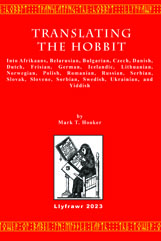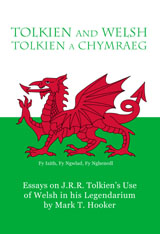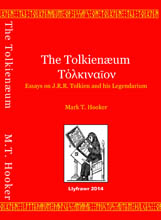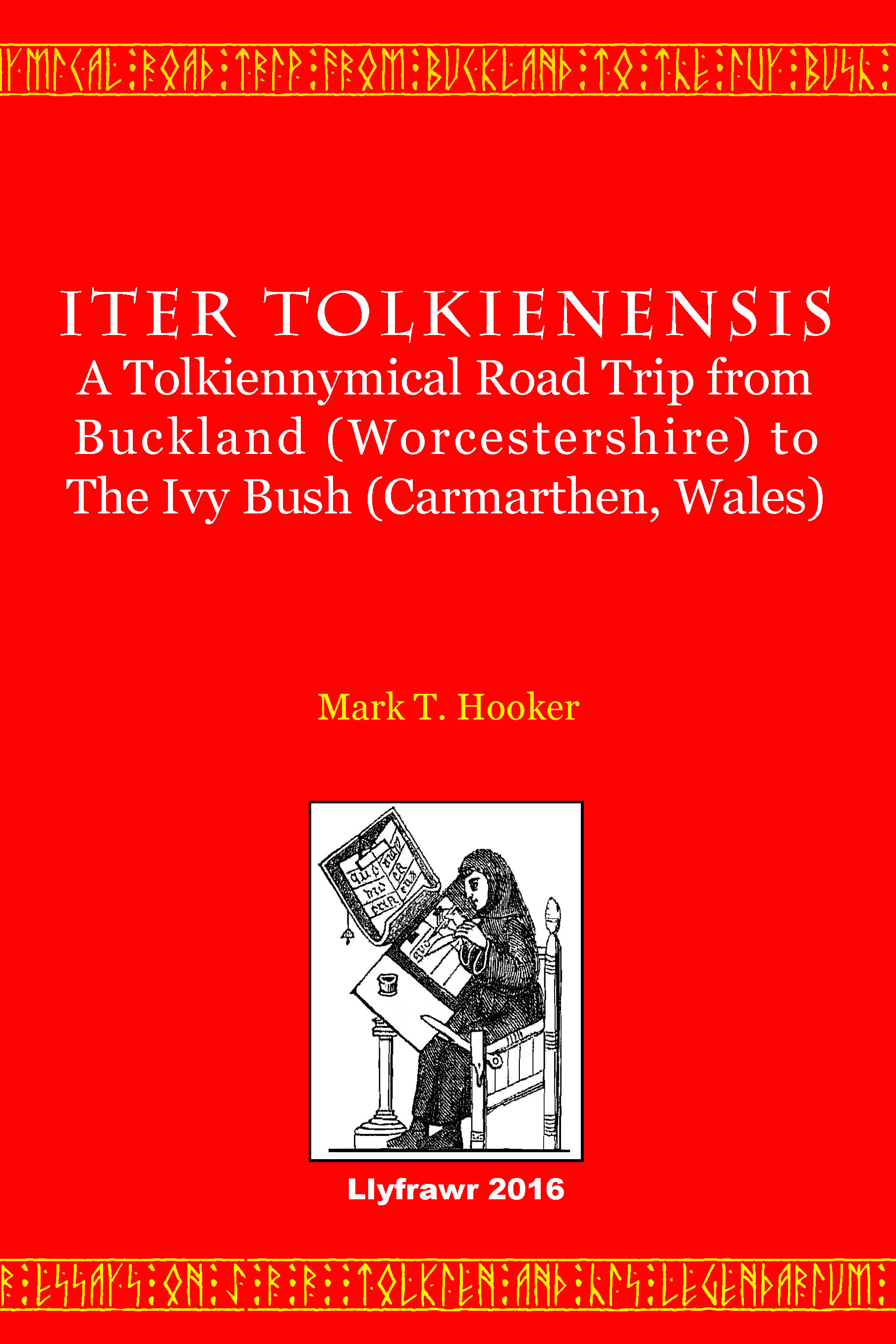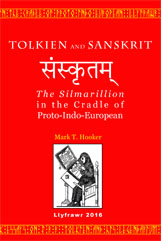Into Afrikaans, Belarusian, Bulgarian, Czech, Danish, Dutch, Frisian, German, Icelandic, Lithuanian, Norwegian, Polish, Romanian, Russian, Serbian, Slovak, Slovene, Sorbian, Swedish, Ukrainian, and Yiddish
|
Also by this author: | Language DefinitionsA language Is a Dialect with an Army and Navy “A language is a dialect with an Army and Navy” is a witticism about the place of Yiddish in the World that was popularized by sociolinguist and Yiddish scholar Max Weinreich (1894–1969), after hearing it from someone who came up to talk with him after one of his lectures during World War II. To coin a new definition of the difference between a language and a dialect for the modern day, one might, perhaps, say: a language is a dialect with a translation of The Hobbit. This project looks at the Yiddish, the Frisian, and the Upper Sorbian translations of The Hobbit, which are all languages without an Army or Navy. There are, however, no separate American-English, Swiss- German, Austrian-German, or Flemish (the Dutch spoken in Belgium) translations, all of which are spoken in countries with an Army (and Navy). In Nomenclature, Tolkien cites forms in Middle-English, Old English, Danish, Dutch, French, Middle High German, Old High German, Modern German, Icelandic, Old Norse, Norwegian, and Old Swedish. During his work on the article for the word wasp at the Oxford English Dictionary, notes Carpenter, Tolkien demonstrated his skills as a comparative philologist by citing related forms in Old Saxon, Middle Dutch, Modern Dutch, Old High German, Middle Low German, Middle High German, Modern German, Old Teutonic, primitive pre-Teutonic, Lithuanian, Old Slavonic, Russian, and Latin. (Carpenter 113) Germanic Languages German (GM) — is spoken in Germany, Austria, and Switzerland. It is West-Germanic Indo- European language, along with English, Frisian, and Dutch. Written German is generally quite uniform, but there are a number of dialects of spoken German. Tolkien observed that his interest in German came from his mother (Mabel Tolkien née Suffield) who “knew German” and gave him his “first lessons in it.” While at King Edward’s School, Tolkien won the German Prize on Speech Day in 1907, having been the runner-up the year previous. Tolkien’s supervisor at the Oxford English Dictionary, wrote that Tolkien had “an unusually thorough mastery of Anglo-Saxon and of the facts and principles of the comparative grammar of the Germanic languages.” (C&G ii.465-6) The ability to read German was de rigueur for academics studying linguistics in Tolkien’s day (and on into mine), because the Germans were on the leading edge of linguistic studies. Yiddish (YD) — is the language of the Ashkenazic Jews of Central and Eastern Europe. Yiddish is a fusion language incorporating elements of German, Hebrew, and some Slavic languages. The similarity with German can be seen in the titles of the German and Yiddish translations:
Yiddish was considered a “folk” language, a jargon, spoken by ordinary people, who were illiterate in the more prestigious Hebrew. Hebrew was the language of Jewish liturgy, rabbinic literature, intra-Jewish commerce and poetry, and is today the national language of Israel.
Yiddish is normally written with the Hebrew alphabet, but—as in the case of the translation used in this study—Romanized (written with Latin letters) texts can also be found. Dutch (NL) — is spoken in the Netherlands and in northern Belgium (where it is called Flemish). It is a West-Germanic Indo-European Language. A wide variety of spoken dialects are encountered, but written Dutch is reasonably standard. Many Dutch speak good English. Afrikaans (AF) — is a language sometimes known as ‘Cape Dutch.’ It is spoken in South Africa. It developed from the seventeenth-century Dutch spoken by the European colonists. Afrikaans and English are the only Indo-European languages to be found among the many official languages of South Africa. While Dutch and Afrikaans—especially in written form—are generally mutually intelligible, there are more differences than between British and American English. Frisian (FR) — is the West-Germanic Indo-European language most closely related to English. Graduate students in linguistics are taught the rhyme “Bread, butter and green cheese is good English and good Fries,” which sounds very much the same in Frisian “Brea, bûter en griene tsiis is goed Ingelsk en goed Frysk.” Formerly, Frisian was spoken in the area that is now the province of Noord-Holland (North Holland) in the Netherlands, and along the North Sea coast to the northeastern part of modern Schleswig-Holstein, Germany. Currently, Frisian has splintered into three dialects:
Danish (DK) — is a North-Germanic Indo-European language. It is spoken in Denmark, Greenland and the Faroe Islands. Danish is a descendant of Old Norse, the common language of the Germanic peoples who inhabited Scandinavia during the Viking Era (circa ninth to thirteenth centuries). Most Danes speak fluent English. The close relationship to English is seen in words like datter (daughter), hus (house), arm (arm), sten (stone). An even closer relationship is seen in Scotland, where the Scots words keek (look), ken (know), bairn (child) have Danish cognates: kigge, kende, barn. Swedish (SW) — is likewise a member of the North-Germanic Indo-European language family. Prior to the sixteenth century, Danish influence was very strong, but vigorous efforts were made to counter this situation, and modern Swedish is commonly dated from 1526, when a Swedish translation of the New Testament was published. Today, written Norwegian and Danish are typically more or less easily understood by Swedish speakers. The similarity between Danish, Swedish and Norwegian is seen is the translations of the title The Hobbit: Or There and Back Again:
Norwegian (NO) — is also a member of the North-Germanic Indo-European language family. It is classified as a Scandinavian language, in the same dialect continuum with Swedish and Danish. It is a descendant of Old Norse, the common language of the Germanic peoples living in Scandinavia during the Viking Era. There are two variants of Norwegian: Bokmål (literally book tongue) and Nynorsk (new Norwegian). Bokmål developed as a result of a strong, nationalistic need to establish a culturally Norwegian nation, by moving away from the official use of Danish during the Union of Denmark–Norway from 1537 to 1814. Nynorsk brings together the language of the spoken Norwegian dialects outside the urban areas of the Union of Denmark-Norway. Nynorsk is more Norwegian while Bokmål is closer to Danish. Icelandic (IS) — is a senior member of the North-Germanic Indo-European language family. The language preserves more ‘archaic’ features than most other Western European languages, most of which have greatly reduced or eliminated inflection (particularly noun declension). Since the written language has not changed much, Icelanders are able to read classic Old Norse literature created between the tenth and thirteenth centuries (for example The Eddas) with relative ease. Icelandic is not mutually intelligible with the continental Scandinavian languages, but it is more similar to the Scandinavian languages than the most widely spoken West-Germanic languages (English and German). In a letter about the Icelandic translation of The Hobbit, Tolkien wrote that Icelandic was a language that “would fit it [The Hobbit] better than any other I have any adequate knowledge of.” (L.430) The Tolkiens had at least four native-Icelandic- speaking au pairs who lived with them, with whom Tolkien practiced his Icelandic. Slavic Languages Russian (RU) — is an East-Slavic Indo-European language. It was the common language of the Soviet Union (which was broken up on 25 December 1991), yet it remains in use beyond the borders of the Russian Federation in all the post-Soviet nation-states, as well as in Israel and Mongolia. It is one of the six official languages of the United Nations, and the most widely spoken of the Slavic languages. The use of Russian is second only to English on the Internet. While Tolkien was in the hospital in 1917, reports Carpenter, he was “teaching himself a little Russian.” (Carpenter 111) He did not make a lot of progress with Russian, because as he noted in a letter of 1944: “I can't write Russian and find Polish rather sticky yet.” (L.67) In the early drafts of The Hobbit, the name for the character who became Beorn was Medwed. (HotH.228) This is nothing more than the Russian word медведь transliterated into Latin letters using German orthography. Ukrainian (UK) — is an East-Slavic Indo-European language that is spoken in Ukraine, formerly the Ukrainian Soviet Socialist Republic, a part of the Soviet Union. It is closely related to Russian and Belarusian, Belarusian being closer to Russian than Ukrainian. All three languages are to some degree mutually intelligible. Belarusian (BY) — is an East-Slavic Indo-European language that is spoken in Belarus, formerly the Byelorussian Soviet Socialist Republic, a part of the Soviet Union. It was the smallest of the three Slavic republics (Russia, Ukraine, and Belarus) in the Soviet Union. The name of the country and the language literally means ‘White Russian,’ not to be confused with the ‘White Russians’ who fought the ‘Red Russians’ in the Russian Revolution of 1917. Belarus is bordered by Russia to the northeast, Ukraine to the south, Lithuania and Latvia to the northwest, and Poland to the west. Polish (PL) — is a West-Slavic Indo-European language, spoken in Poland, and is the third most widely spoken language in Chicago (after English and Spanish). It is most closely related to Slovak and Czech. It is the most widely spoken West-Slavic language, and the second-most widely spoken Slavic language. Sorbian (HSB) — describes a group of two related, but only partially mutually intelligible, West-Slavic Indo-European languages: Upper Sorbian (hornjoserbsce), spoken by about 40,000 people in Saxony, and Lower Sorbian (dolnoserbski) spoken by about 10,000 people in Brandenburg. This is the Lusatia region of the former East Germany. Historically, these languages were called either Wendish (with reference to the Wends, earliest Slavic people in modern Poland and Germany) or Lusatian. Upper Sorbian was heavily influenced by German, but has clear Polish and Czech influences. Czech (CZ) — is a West-Slavic Indo-European language. It is the official language of the Czech Republic. Czech and Slovak are is closely related, to the point of mutual intelligibility in a wide number of contexts. German has had a lot of influence on Czech. Czech– and Slovak-speaking areas were part the Austrian Empire for a long time, and German was the language of officialdom and the intelligentsia. Czech and Slovak were the languages of the rural populace. Slovak (SK) — is a West-Slavic Indo-European language. It is the official language of the Slovak Republic. Slovak and Czech are is closely related, and have a high degree of mutual intelligibility. In a comparison of Czech and Slovak, Slovak is more conservative phonetically, while Czech undewent more changes starting in the fourteenth century. Slovak should not be confused with Slovene (aka Slovenian), the main language of the Republic of Slovenia, one of the successor states of the former Yugoslavia. Slovene (SLV) — is a South-Slavic Indo-European language spoken in the Republic of Slovenia (south of Austria and Hungary). The South-Slavic languages of the Balkans are separated geographically from speakers of the other two branches (West and East) of the Slavic languages by a belt of German, Hungarian and Romanian speakers. Serbian (SRB) — is a South-Slavic Indo-European language spoken in the former Yugoslavia. When Yugoslavia broke up into separate states, the language that was formerly called Serbo-Croatian, likewise devolved into separate languages: Serbian in Serbia (centered around Belgrade and Novi Sad), Croatian in Croatia (centered around Zagreb), and Bosnian in Bosnia- Herzegovina. Serbian was traditionally written in Cyrillic script, but is now widely found written in Latin script. There are clear differences in vocabulary between Serbian and Croatian: bread, for example, is kruh in Croatian, but hleb/хлеб in Serbian. Serbian has more loanwords from Turkish, Greek and Russian [хлеб (khleb) = bread], while Croatian has more loanwords from German, Latin, and Czech [vlak = train]. Bulgarian (BL) — is a South-Slavic Indo-European language spoken in the Balkans (Southeastern Europe), in the Republic of Bulgaria. Bulgarian’s position among the Slavic languages is akin to English among the Germanic languages. While case structure is alive and well in German and in the other Slavic languages, Bulgarian is based on an analytic structure, like English. Unlike most other Slavic tongues, Bulgarian has a definite article. Many Turkish words were adopted into Bulgarian during the long period of Ottoman rule. Bulgarian is written with the Cyrillic script. Lithuanian (LT) — is one of the Baltic languages. Linguists divide them into two groups: Western Baltic (Old Prussian, now extinct), and Eastern Baltic (Lithuanian and Latvian). Linguists find the Baltic languages of particular interest for comparative studies (Tolkien’s field of study at Oxford), because they retain numerous features that died out in other Indo-European languages as they developed from Proto-Indo-European. The Baltic and Slavic languages were at one time a single branch of Proto-Indo-European, but they later separated, as is demonstrated by a wealth of common lexical, morphological, phonological features, making the Slavic languages the closest living Indo-European relatives to the Baltic languages. Lithuanian is generally held to be the most archaic living Indo-European language, because it preserves archaic features otherwise only found in ancient languages such as early Vedic Sanskrit or Ancient Greek. Romanian (RO) — is an Eastern Romance language of the Italic branch of the Indo-European language family. It evolved from the Vulgar Latin of the Roman Empire, separating from the Western Romance languages (eg. Spanish, Portuguese, and French) between the fifth and eighth centuries. Between 75%–85% of Romanian words can be traced to Latin. It is spoken primarily in Romania and Moldova. There are approximately 22–26 million native speakers. There is, however, a notable Slavic influence on the vocabulary of Romanian. Approximately 10–15% of the modern Romanian lexicon is estimated to be of Slavic origin. “The Romance language Romanian has borrowed so many Slavonic words that scholars for a while believed it was a Slavonic language.”[1] Romanian is the only Romance language in which the definite articles are enclitic (post-position) instead of proclitic (pre-position). This is also a feature of the Scandinavian languages. Compare the Romanian title for The Hobbit (Hobbitul) with the Icelandic (Hobbitinn), Danish (Hobbitten), Norwegian and Swedish (Hobbiten). [1] - Robert Lawrence (Larry) Trask, Trask’s Historical Linguistics, revised and edited by Robert McColl Millar, third edition, London & New York: Routledge. 2015, p. 292. © 1996. |
Pagination: xviii + 270. Trade Paper $14.95.
To learn more about the book, follow the links below.

